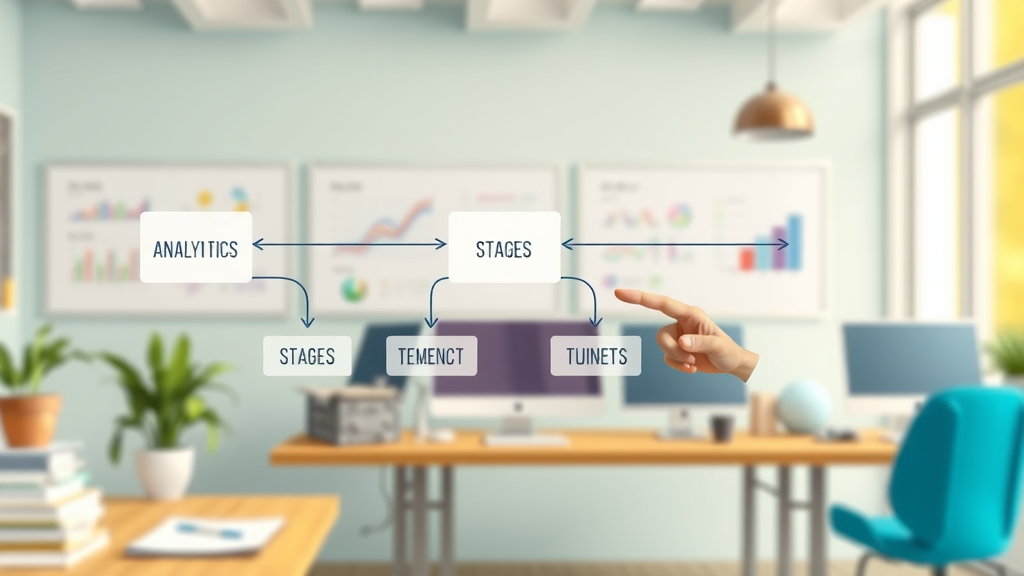
Did you know that over 90% of marketers believe social media analytics have completely transformed the way they plan and optimize campaigns? In the rapidly evolving digital landscape, using analytics tools is no longer a luxury for global brands—it’s an essential ingredient for real-time growth and sustainable success. If you’re curious how leading businesses outpace the competition or want to pinpoint what’s propelling (or stalling) your brand’s success, this guide will break down social media analytics from the inside out. Uncover the right data, master powerful analytics tools, and shift guesswork into strategic, data-driven growth.
Unlocking Social Media Analytics: The Key to Data-Driven Growth
In today's competitive environment, social media analytics serve as the backbone of successful media marketing strategies. By analyzing data points from your various social media channels, you can spot trends, measure growth, and tweak your approach for the highest impact. The real power lies in turning consistent streams of social media data into actionable insights, identifying which platforms, content types, or marketing campaigns are driving traffic, engaging audiences, or boosting conversions.
For instance, by leveraging robust analytics tools, a company might discover that video content outperforms images in engaging their target audience on Instagram, while community polls lead to spikes in interactions on Twitter. With a clear view of key performance indicators (KPIs), brands of all sizes can move from reactive, guess-based tactics to proactive, results-driven campaigns. Whether you’re monitoring share of voice or tracking conversion rates, mastering social media analytics ensures every move you make is guided by solid, insightful media data.
“90% of marketers say social media analytics have fundamentally changed their approach to campaign planning, enabling real-time performance improvements.”
Understanding Social Media Analytics: Definition and Core Concepts
What Is Meant By Social Media Analytics?
Social media analytics is the systematic collection, processing, and interpretation of data from social networks, such as Facebook, Instagram, X/Twitter, LinkedIn, and others. Through this process, marketers and businesses can get a granular view of how their content, advertising, and engagement efforts are performing in real time. By closely monitoring media metrics such as engagement rate, impressions, reach, and sentiment analysis, brands can extract actionable insights that directly inform future strategies.
In simple terms, social media analytics tools take massive volumes of social media data—every like, share, comment, and click—and transform them into clear reports and visual dashboards. These tools help track how well your brand is resonating with the target audience, spot trending topics, and detect shifts in consumer preferences and media performance. By viewing these data points collectively in a social analytic or media report, businesses can connect the dots between social activity and tangible business outcomes.

Why Social Media Analytics is Essential for Modern Brands
Modern brands can't afford to operate in the dark. Social media analytics tools provide critical business intelligence by helping companies see which content resonates, which influencers drive ROI, and where customers are most active. With actionable insights generated from analytics tools, you’re not just evaluating past performance—you’re predicting what’s next in your industry.
By integrating analytics tools into every aspect of their social media marketing efforts, brands gain the ability to fine-tune campaigns mid-flight, optimize spending, and avoid wasted resources on underperforming initiatives. The real magic of media analytics lies in the ongoing loop of testing, learning, and evolving, ensuring your media campaigns are always one step ahead of shifting consumer behaviors and new trends across media platforms.
The Anatomy of Social Media Analytics Tools
How Social Media Analytics Tools Collect and Process Media Data
Analytics tools aggregate vast amounts of social media data from multiple social media channels and media platforms. They pull raw information—such as likes, shares, comments, demographic engagement, and content performance—using application programming interfaces (APIs) that platforms like Facebook and Instagram provide. This data is then processed with algorithms that group, segment, and visualize information in real time, transforming complex streams of data analytics into digestible dashboards and automated media reports.
Beyond basic numbers, advanced media analytics tools incorporate natural language processing, machine learning, and sentiment analysis to decode trends in conversations and brand mentions across the social network ecosystem. These features allow marketers to identify positive or negative audience sentiment around a product or campaign, providing a holistic view of media performance. Whether you’re launching a new marketing campaign or monitoring the health of ongoing initiatives, the constant inflow of media data offers guidance for timely and focused decision-making.

Choosing the Right Social Media Analytics Tool for Your Business
Not all analytics tools are created equal. Selecting a social media analytics tool that aligns with your business goals starts with evaluating where your audience lives and how you measure success. Does the tool integrate with all your active media platforms? Does it deliver real-time analytics, ultra-visual KPI reports, and offer historical comparisons for tracking long-term growth? Checking these criteria ensures you pick a tool that scales with your evolving strategy.
Advanced features such as social listening, automated media reporting, and in-depth sentiment analysis are increasingly vital. Beyond just numbers, they provide the context that helps brands understand the “why” behind fluctuations in engagement or shifts in audience mood. Excellent customer support and robust integration options with other marketing software can also be the difference-maker, making sure your team can focus on action over troubleshooting.
- Assess platform compatibility with your active social media channels
- Verify the depth of analytics reports—visuals, KPIs, historical comparison
- Seek advanced features such as sentiment analysis and social listening
- Ensure robust customer support and integration options
| Tool | Features | Supported Platforms | Unique Capabilities |
|---|---|---|---|
| Brandwatch | Deep listening, customizable dashboards, sentiment analysis | Facebook, Twitter, Instagram, LinkedIn, TikTok | Industry benchmarking, global data access, predictive insights |
| Sprout Social | Automated reporting, smart inbox, content optimization | Facebook, Instagram, Twitter, LinkedIn | CRM integration, chatbot automation, trend detection |
| Hootsuite Insights | Real-time analytics, engagement metrics, post scheduling | Facebook, Instagram, LinkedIn, Twitter, YouTube | Team collaboration, competitive analysis, sentiment tracking |
| Google Analytics for Social | Traffic source tracking, in-depth campaign data, goal conversion | All social networks (via website tracking) | Custom goal setup, integration with Google Ads, funnel visualization |
Key Metrics in Social Media Analytics: What to Track and Why It Matters
The Four Types of Social Media Analytics
To truly leverage the full potential of social analytics , it’s crucial to understand the four primary analysis types: Descriptive (what happened?), Diagnostic (why did it happen?), Predictive (what could happen?), and Prescriptive (what should be done?). Each contributes a unique perspective to your social media data, enabling brands to identify wins, losses, patterns, and untapped opportunities across their media channels.
Descriptive analytics help you report past media performance (for instance, total engagement by week). Diagnostic analytics dig deeper into the reasons for success or declines, spotlighting content types or social media campaigns that caused spikes or slumps. Predictive analytics harness historical media data to forecast trends and future outcomes, while prescriptive analytics suggest concrete next steps based on patterns, taking guesswork out of content planning and budget allocation.

Social Media Performance: Core KPIs That Reveal Brand Success
Tracking the right social media metrics is essential for evaluating the effectiveness of your campaigns. Every data point matters, but certain KPIs carry more strategic weight. Here’s what top brands routinely monitor to sharpen their competitive edge and ensure their efforts translate into measurable progress across social media channels:
- Engagement Rate – Measures likes, shares, comments, and overall interactions to reveal how compelling your content truly is.
- Reach and Impressions – Quantifies how many unique users have seen your posts versus total times your content was displayed.
- Follower Growth – Tracks changes in your social network’s size, signaling brand momentum or stagnant reach.
- Share of Voice – Compares your brand’s mentions with competitors’ to gauge industry presence and authority.
- Conversion Rate – Monitors how many social views or clicks successfully generate leads, downloads, or purchases.
Assessing these KPIs regularly through an analytics tool transforms raw data into actionable insights for smarter, more impactful marketing decisions.
Applying Sentiment Analysis in Social Media Analytics
Sentiment analysis is a game-changer in social analytics, providing real-time insight into audience mood and conversation tone. By scanning interactions, reviews, and comments for emotional keywords, this analytics tool can rapidly identify when a brand is trending positively—or facing potential backlash.
Modern media analytics tools blend AI and machine learning to monitor sentiment spikes or dips, tracking the impact of new launches, prominent influencers, or even ongoing crises. These actionable insights can be fed back into content strategy, helping brands preempt negative cycles or champion successful initiatives across media platforms. Ultimately, tracking sentiment is vital for brands that value reputation management and want to nurture authentic engagement in every media report.

Beyond the Numbers: Turning Social Media Data Into Actionable Insights
Transforming Social Media Reports Into Usable Strategies
Turning a social media report into effective action requires more than just data gathering—it means interpreting the story behind the metrics. Marketers should look for trends and patterns, such as recurring audience spikes during specific campaigns, sharp drops in engagement after schedule changes, or clear links between content themes and conversion rates.
Effective analytics tools allow you to layer these findings, creating adaptable media marketing strategies aligned with KPIs and business goals. By prioritizing actionable insights over vanity metrics, brands can deploy targeted content, allocate spend efficiently, and consistently replicate what works best, driving continuous growth across every social media channel.

Using Social Listening to Power Proactive Media Marketing
Social listening is an advanced form of social media analytics, focusing not just on your owned pages but on broader conversations throughout the digital landscape. By monitoring direct and indirect mentions, hashtags, and trending discussions, brands gain immediate feedback on public opinion, brand sentiment, and emerging opportunities for engagement.
This proactive use of media analytics tools allows companies to join trending conversations, mitigate crises early, or even spot the perfect moment for launching new media campaigns. The combination of social listening and actionable insights helps marketers consistently align their messaging with their target audience’s evolving needs, creating more authentic connections across every media channel.
The 50/30/20 Rule for Social Media and Its Role in Analytics
What Is the 50/30/20 Rule for Social Media?
The 50/30/20 rule is a proven content strategy framework ensuring content diversity and balance across your social channels. According to this rule, 50% of your posts should deliver value (educational or informative), 30% should be shared from other sources or the community (curated/engagement-driven), and 20% should directly promote your brand, product, or services.
Media analytics tools can track the distribution of your content and identify whether you’re maintaining this essential mix. By sticking to the 50/30/20 breakdown, brands foster trust, provide recurring value, and avoid being perceived as overly sales-focused—all of which can measurably improve social media performance over time.

Seven Layers of Social Media Analytics: A Deep Dive
What Are the 7 Layers of Social Media Analytics?
For advanced practitioners, social media analytics comprises seven targeted layers that offer a 360-degree understanding of your digital presence. Each layer focuses on a specific aspect of your media data ecosystem, revealing new avenues for optimizing campaigns and building brand equity.
- Content Analysis: Evaluates topics, formats, and timing for highest engagement.
- Channel Analysis: Assesses which media channels are delivering the best ROI.
- Audience Insights: Uncovers demographic and psychographic details about your target audience.
- Engagement Monitoring: Tracks likes, shares, comments, and link clicks in real time.
- Sentiment Assessment: Uses sentiment analysis to measure audience feelings about your brand or campaigns.
- Influencer Identification: Finds key voices and advocates amplifying your message on social platforms.
- Conversion Attribution: Connects social efforts to real business outcomes—leads, sales, or sign-ups.
Layering these analytics helps brands advance from mere observation to continuous, campaign-level improvement—setting the foundation for true social analytic mastery.

Emerging Trends in Social Media Analytics Tools
Integration of AI and Predictive Data Analytics
Artificial intelligence (AI) is rapidly transforming media analytics tools by automating everything from pattern recognition to predictive forecasting. By leveraging advanced AI, social analytics platforms can forecast upcoming trends, provide content recommendations, and detect anomalies in user behavior—all faster and more accurately than ever before. This empowers marketers to plan with data analytics foresight and respond proactively to changes in user sentiment, boosting campaign success and long-term social media performance.
Predictive analytics takes things further by proactively identifying which future content topics will likely resonate with your target audience, allowing for smarter budgeting, posting, and media campaign alignment based on real data rather than intuition.
Cross-Platform Analytics: Unifying Data Across Media Channels
One of the biggest challenges for media marketers is piecing together performance across so many different platforms. Cross-platform analytics tools unify data from all social media channels, providing a single pane of glass to monitor audience activity, identify best-performing media campaigns, and reduce blind spots.
With a holistic media analytics approach, brands can spot which media channels complement each other, allocate resources based on platform strengths, and maintain consistent storytelling everywhere they have a digital footprint. This results in smoother, data-driven decision-making and a more robust media marketing strategy.

The Rise of Real-Time Social Analytics
In an age where trends shift overnight, real-time analytics are revolutionizing social media marketing. Modern media analytics tools now deliver up-to-the-minute performance tracking, notification alerts for viral moments or crises, and instant competitor benchmarking. This allows brands to respond immediately—amplifying wins and neutralizing threats across all media platforms as they emerge.
Whether it’s a sudden surge in engagement after a major announcement or a potential PR issue, having access to current social networking data is essential in today’s high-speed digital world.
Navigating Social Media Analytics Challenges
Managing Data Overload Across Social Media Analytics Tools
With so many media analytics tools and hundreds of data points streaming in every day, the risk of “analysis paralysis” is real. Marketers often get lost sifting through massive volumes of social media data, struggling to differentiate actionable insights from distracting noise.
The solution lies in focusing on the key KPIs that drive growth and automating low-priority reporting tasks. Smart dashboards now allow marketers to filter information, highlight what matters, and generate custom media reports that spotlight only the most relevant media metrics.

Maintaining Data Privacy and Compliance
As digital scrutiny grows, brands must ensure their use of social media analytics is fully compliant with data protection laws (like GDPR or CCPA). Marketers must always obtain consent, anonymize sensitive social network data, and regularly audit analytics tool operations for legal and ethical compliance.
Leading media analytics tools offer built-in safeguards, secure storage, and user-friendly privacy settings—allowing businesses to gain powerful media data insights without jeopardizing audience trust or risking regulatory penalties.
Harnessing Social Media Analytics for Competitive Advantage
Benchmarking Social Media Performance Against Industry Leaders
Comparing your media performance with industry benchmarks reveals where you’re excelling and where there’s opportunity for growth. Social media analytics tools can automatically scan competitors’ engagement rates, content mix, and share of voice, empowering you to spot gaps and identify new strategies.
This type of benchmarking isn’t just about keeping up; it helps brands leap ahead by imitating proven tactics, setting realistic goals, and measuring success with confidence—fueling sharper, more resilient media campaigns.
Measuring Influencer Impact With Media Analytics Tools
Influencer partnerships can have a major effect on brand reach and credibility—but only if their impact is measured precisely. Media analytics tools help brands assess each influencer’s ability to drive engagement, grow followers, and spark conversions across the social media platform spectrum.
By tracking data points such as average engagement per post, click-through rates from influencer content, and share of voice generated during co-promoted campaigns, brands can invest with confidence in partnerships that deliver authentic ROI.

People Also Ask: In-Depth Social Media Analytics Questions Answered
What is meant by social media analytics?
Social media analytics refers to the processes and tools used to collect, process, and interpret data from social networks. It helps brands understand audience engagement, content performance, and overall trends across channels by transforming detailed social network interactions into actionable business strategies.
What is the 50/30/20 rule for social media?
The 50/30/20 rule is a content strategy method that recommends splitting your posts into 50% value-driven content, 30% curated or community content, and 20% direct promotional content. This helps brands maintain engagement while gradually moving audiences toward conversion without overwhelming them with sales-focused messages.
What are the four types of social media analytics?
The four main types are Descriptive (what happened), Diagnostic (why it happened), Predictive (what could happen), and Prescriptive (what to do next). Together, they create a comprehensive framework for measuring performance and directing future campaigns.
What are the 7 layers of social media analytics?
The 7 layers include Content Analysis, Channel Analysis, Audience Insights, Engagement Monitoring, Sentiment Assessment, Influencer Identification, and Conversion Attribution. These combined offer a deep view into all facets of your social media presence, helping drive continuous improvement.
Frequently Asked Questions on Social Media Analytics
- How can small businesses get started with social media analytics tools? Start with a basic analytics tool integrated into your core platforms (like Facebook Insights). Track simple metrics—engagement rate, post reach, follower growth—and gradually layer on more advanced tracking as your needs grow.
- Which analytics tool works best for Instagram or Facebook? Tools like Sprout Social, Hootsuite, and Facebook Insights all work well for these platforms, providing detailed media reports and actionable recommendations tailored to their unique algorithms.
- Can social media analytics improve paid social campaigns? Absolutely. Aligning paid content strategies with organic data (such as which posts perform best or audience preferences) can help maximize ad spend and improve your return on investment.
- What’s the difference between media analytics and social listening? Media analytics focuses on quantitative performance metrics; social listening analyzes qualitative conversations and sentiment across the social network, providing broader context for decision-making.
Building Your Data-Driven Social Media Marketing Strategy
Developing Action Plans Based on Analytics Reports and Social Media Performance
Data-driven social media marketing means building every campaign and piece of content on evidence—not hunches. Use analytics tools to track which efforts move the needle, then adapt upcoming calendars and creative to double down on what works. Social media performance data should guide everything from influencer partnerships and content timing to budget allocation and even customer care processes.
Regularly review and share select social media reports with your team to ensure alignment around KPIs and encourage a culture of constant improvement. This data-centric alignment will keep you ahead of both shifting trends and competitors.
Key Takeaways: Mastering Social Media Analytics for Lasting Growth
- Consistently monitor core metrics across your social media channels
- Embrace automation and predictive analytics tools
- Link analytics insights directly to KPIs and business outcomes
- Keep data privacy at the forefront of your strategy
Ready to Revolutionize Your Media Marketing?
Feeling overwhelmed by digital marketing? We’ll map out a strategy tailored to your goals— (513)463-7269 .
Start small, scale up, and let social media analytics guide every step of your brand’s digital growth journey.
To deepen your understanding of social media analytics and its impact on business growth, consider exploring the following resources:
- “What Is Social Media Analytics? Social Media Analytics Definition” ( wix.com )
This article provides a comprehensive definition of social media analytics and outlines its key benefits, such as measuring return on investment (ROI), understanding audience behavior, and monitoring competitors’ campaigns.
- “Social Media Analytics: Insights, Strategies & more | Sprinklr” ( sprinklr.com )
This resource offers a step-by-step approach to developing a high-performing social media analytics strategy, including defining goals, choosing the right metrics, and using unified analytics tools.
If you’re serious about leveraging social media analytics to drive your brand’s growth, these resources will provide you with the foundational knowledge and strategic insights needed to make informed, data-driven decisions.
 Add Row
Add Row  Add
Add 




Write A Comment